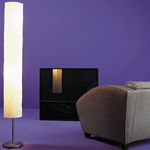HT Boot Camp: Sometimes, It's Good to Be Biased . . .
 . . . especially when it allows you to make the most of your viewing experience.
. . . especially when it allows you to make the most of your viewing experience. As we move into the new digital-broadcasting world with new displays and new toys, we need to embrace the standards for viewing. For the most part, CRT technology will be with us for a long time. Mixed in will be the flat-panel displays and projectors. As with the audio rules of thumb, there are video-viewing-environment rules. The monitor will be in the same spot, and the speaker separation will be relatively the same (even with 10.2 channels), so we need to be sure the visual conditions are set for more-relaxing viewing. The video in the features we're watching is made up of fast cuts, bright explosions, and dark, calm scenes. Although a good monitor will handle this contrast range, sometimes your eyes can't. In a darkened room, the light-to-dark transitions in these scenes can detract from the viewing experience. Several years ago, a committee was formed under the standards body SMPTE (Society of Motion Picture and Television Engineers). This "monitor-calibration committee" did extensive research in the physics of what these changes in the picture level do to the viewer and what can be done to relieve the strain from such drastic changes.
The criteria for an optimum viewing environment was researched, and several interacting elements were considered. Along with speaker placement, picture placement was worked out and then tested. This isn't easy because the monitor and center channel theoretically need to be in the same spot, so a series of compromises were made.
 The monitor needs to be at eye level or about 2 degrees down from center and four picture heights away from center. The distance dictated is the point where the viewer looses the perception of the interlaced lines. Progressive-scan monitors (computer monitors) can be about 22 inches closer. The center speaker should then be placed on top of or just below the screen. This is all well and good, but there is one other factor: the contrast change. There needs to be a way to bias the eyes from these changes.
The monitor needs to be at eye level or about 2 degrees down from center and four picture heights away from center. The distance dictated is the point where the viewer looses the perception of the interlaced lines. Progressive-scan monitors (computer monitors) can be about 22 inches closer. The center speaker should then be placed on top of or just below the screen. This is all well and good, but there is one other factor: the contrast change. There needs to be a way to bias the eyes from these changes.
Bias is the key word here. In researching the action of the eyeball, what happens is that the iris is constantly adjusting, opening and closing for the light-to-dark changes. Viewing an action movie in a completely dark room . . . well, you can imagine how fast this is happening. A great example is a True Lies explosion scene in the afternoon with a bright sky, followed by a dark night scene. For the first two to three seconds, the dark scene will look like a black picture, but in fact you just can't see those first few frames of the film. The scenes change faster than some people's irises can react—that's why you don't see anything for those few seconds. There needs to be an external light that will not interfere with the effect that the director intended on the screen. This way, the iris never adjusts itself from closed to fully open. It goes to extremes, but never fully closed to fully open.
- Log in or register to post comments


























































